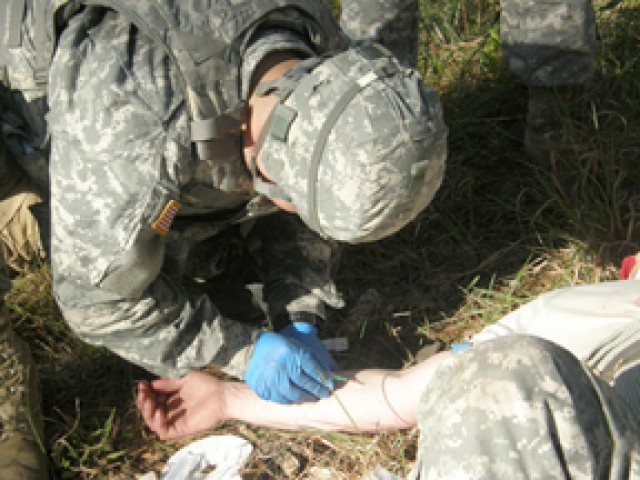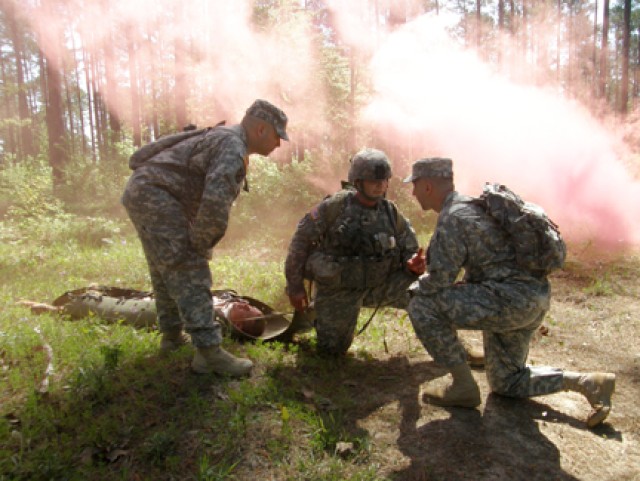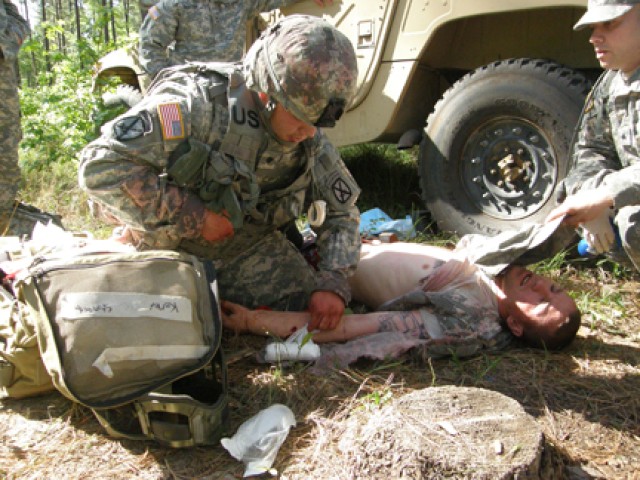FORT POLK, La. -- Thoughts of life and death in a combat zone can consume a Soldier. Having confidence in the first line of medical assistance when the worst happens is critical to Soldiers putting aside those fears and focusing on the mission at hand. The medics of 2nd Battalion, 4th Infantry Regiment, 4th Brigade Combat Team, 10th Mountain Division conducted trauma lanes April 15 to ease anxieties in fellow Soldiers by continuing to improve their medical skills. This intense, day-long training takes on the feel of macabre theater in which every Soldier plays a part to demonstrate the realities of combat medicine.
The Soldiers of the 2nd Bn, 4th Inf Reg perform the dual role of infantry Soldier and medic. "We are combat medics. If you are in 2-4, you're what's considered a line medic. We have the skills of an infantry Soldier and we use them in conjunction with our medical skills. We are Soldiers first, but we're also the guy that answers the call when someone yells 'medic,'" said Spc. Marcus Semelis.
Having his Soldiers engage in the challenges of the day is something Staff Sgt. James Dupree, the NCO officer in charge, believes is key to making them more successful during their upcoming deployment. "The more realistic the training, the better prepared these guys are going to be when they get to Afghanistan. We need to get as much realistic medical training in before we deploy so that if they do have to deal with injuries or casualties, they're prepared. This will give them the confidence and understanding to keep their patients alive. That's why Soldiers new and old are going to get a crash course in trauma medicine today," said Dupree.
For a Soldier that's never experienced this type of exercise, the situation can be intimidating. Pvt. Sean Hasner is only a week out of advanced individual training. "I think they are going to be pretty hard on us, especially the new Soldiers, but I see it as a good learning experience," said Hasner.
More experienced Soldiers said they see the lanes as a necessary part of the learning process. "We're here today to do some training and see what people know and don't know. This is where we learn and can make mistakes. Not learning from this training isn't an option for us because when we make mistakes over there, our mistakes don't come home," said Semelis.
Plans for different scenarios were set up throughout the day. "We've got one scenario that's actually going to be a vehicle that got hit by an improvised explosive device. It's from a real incident when we went to Afghanistan in 2006," said Dupree.
There were three lanes going simultaneously and each Soldier executed a lane individually. Medics set to begin their scenario received a brief where they were then linked Dupree warned his Soldiers that when the day was over, they would be mentally and physically exhausted.
He explained that graders and other Soldiers were going to play the parts of squad leaders, team leaders and the battle buddies of Soldiers that have been injured to employ as many stress factors as possible. In addition, the graders watch and guide Soldiers through training.
"Graders look at their proficiency and identify things they need to brush up on. Casualties have multiple wounds and medics have to follow certain procedures for different types of wounds. They make sure things are done right and in the correct battlefield sequence," said Dupree.
This on-the-job-training is powerful due to lifelike action that includes sound effects, fake wounds, blood and smoke. This combination was an assault on the senses that bombarded Soldiers at every turn. The sound system is new this year, which added a serenade of rapid-fire gunshots and explosions as the background music to this bloody lesson in the reality of combat medic training. "The sound system adds background noise just like combat will. We can bark and scream at them all day long and they start to tune us out, but the sound system is continuous. It adds combat noises that we can't mimic any other way," said Dupree.
Once scenarios began, teaching was intense. Verbal commands were hurled at Soldiers assessing their patient's condition, causing them to make snap decisions under highly stressful conditions. "I want to make it as miserable and realistic an experience as possible and as close to the reality of theater as possible," said Dupree.
He said the need for speed is imperative for the wounded in a battle situation. Instructors drill the medics to the point that they don't have to stop and think about what to do. The ability to assess an injury and begin proper treatment can then become second nature.
This point hits home as Dupree yelled at one of his medics during a scenario, "Move with a purpose, I've seen snails in salt move faster." Dupree said he loves to teach his Soldiers and hates having to be so tough on them, but in the long run it's going to make them better medics.
After completing his trauma lane, Spc. Eduardo Lopez explained some of what he experienced. "I think I did OK, but I know I could have done better. This training is a mind game. The whole time they were messing with me I kept telling myself to keep my head on straight. I'm trying to keep a wall up in my head and they keep trying to break it down. Eventually, they got me. In the real world, there isn't that much distraction. There's stuff going on, but it's not all centered on you. The training makes it easier when you deploy because taking care of your patient is much easier to concentrate on. When you go overseas your resistance is so high that the stuff that happens doesn't bother you," said Lopez.
Another medic who completed his scenario was Pfc. Kenon Lamb, 2nd Bn, 4th Inf Reg.
He said he felt his medical performance was pretty good, but the physical aspect of the training was more difficult that he expected. "It was grueling. Pulling the casualty back to the evacuation site was the hardest part for me. He was a big guy," said Lamb.
Once a scenario is over, Soldiers and graders discuss their performance and break down what was done right and what still needs to be worked on.
After all, a trauma lane probably isn't like any other learning experience they've ever had. "You can learn the basics at AIT, but this is where you really put your medical knowledge to the test.
Some things learned in the classroom environment sound great, but they aren't applicable to the field environment. This training enables us to see the difference and make the adjustment," said Semelis.
Learning those differences are what Dupree said sets his medical platoon apart. "They train over and over and they have heart."
In the end, Dupree said the purpose of the training was clear. "I'll send Soldiers home walking, on crutches or in a chair, but I don't want to send them home in a box. These (casualties) are the guys putting their lives on the line, they are the ones that matter."






Social Sharing